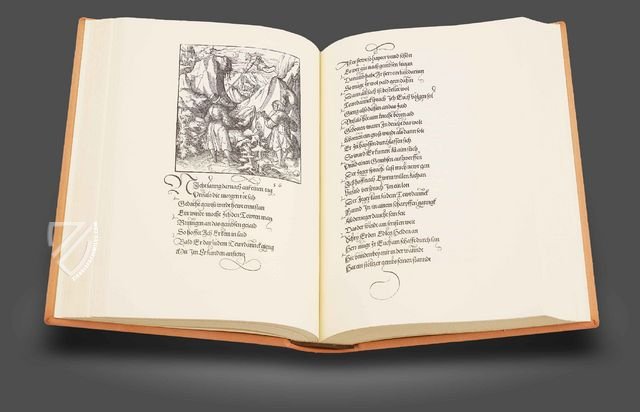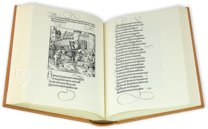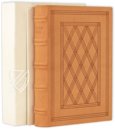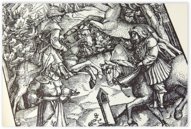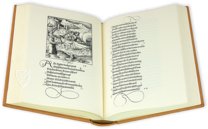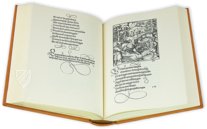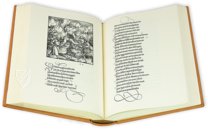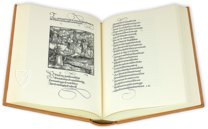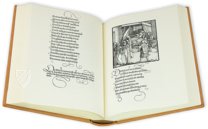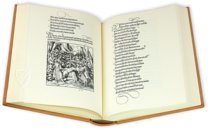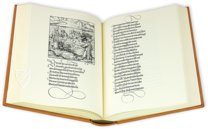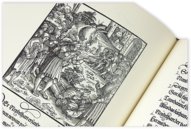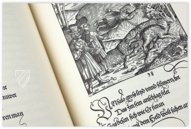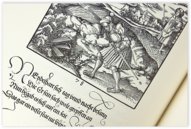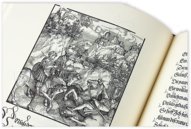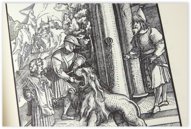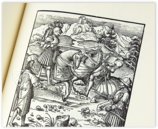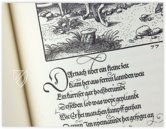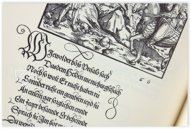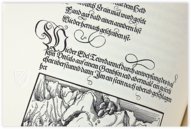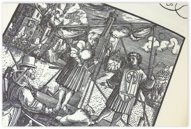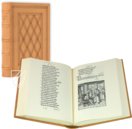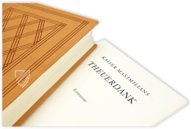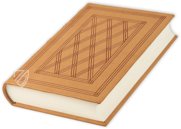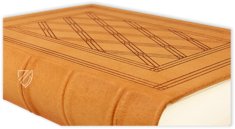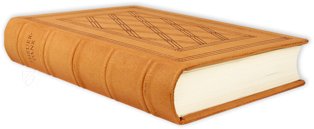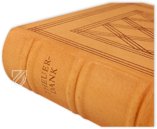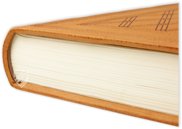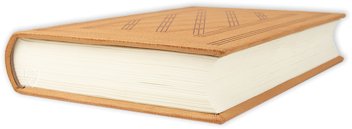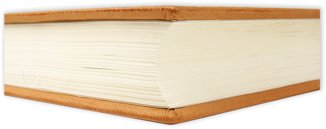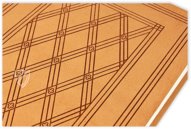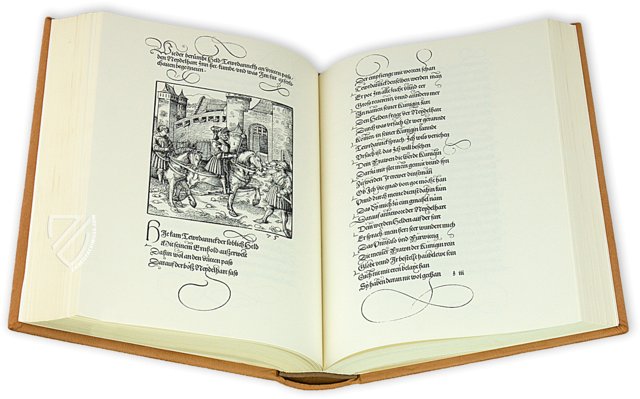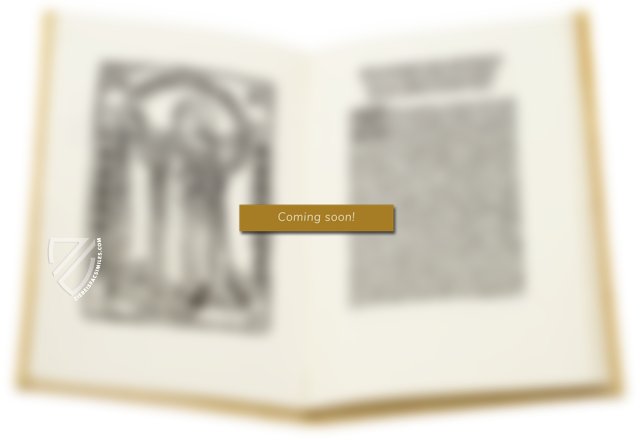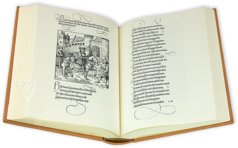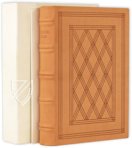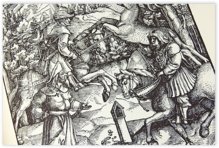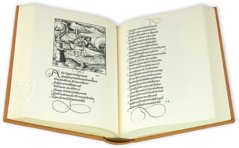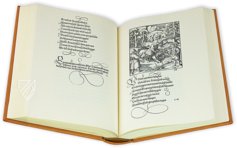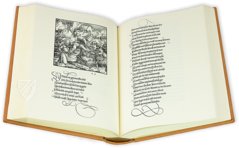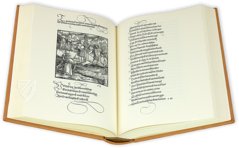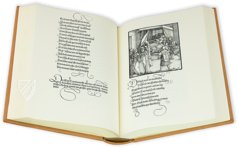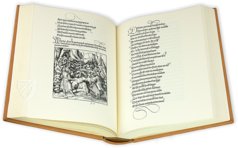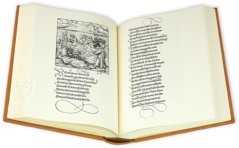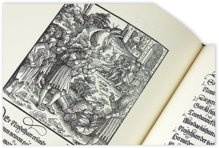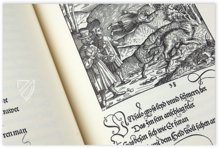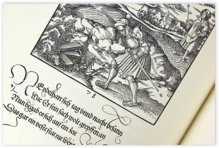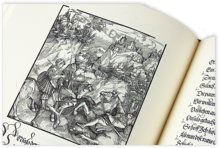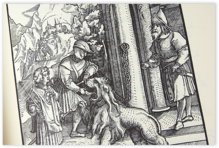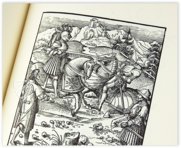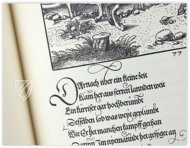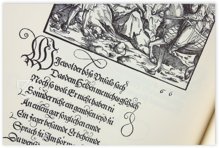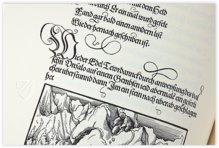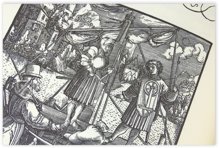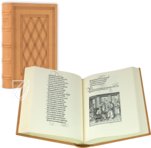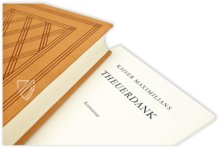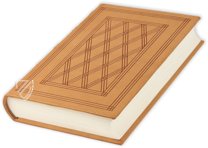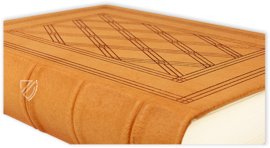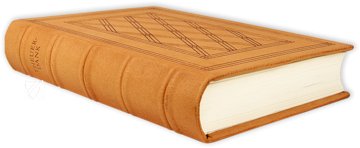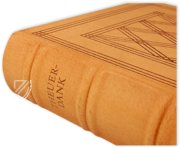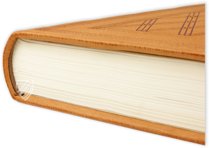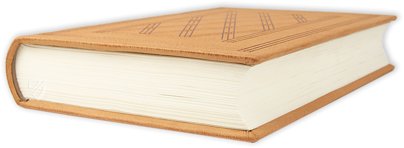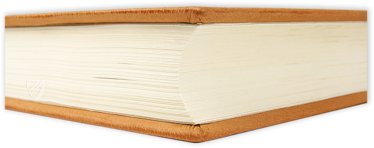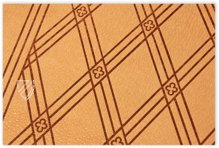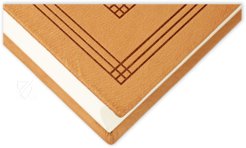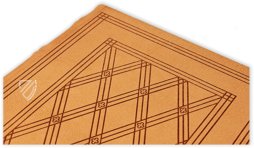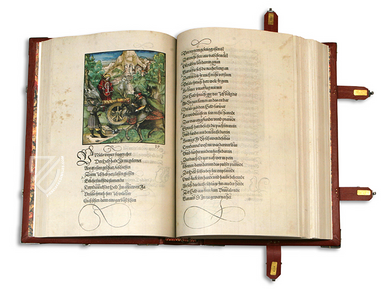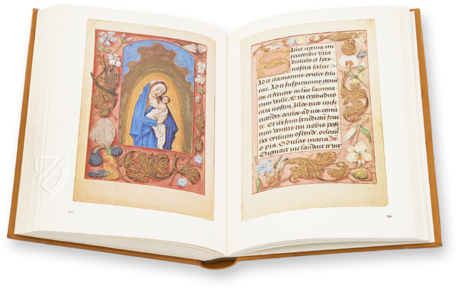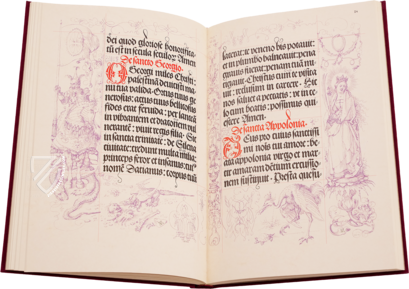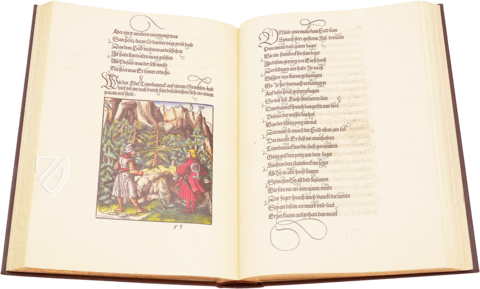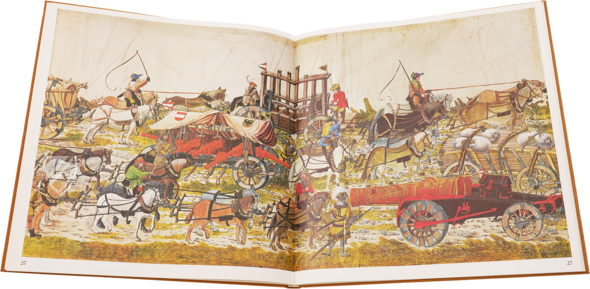Emperor Maximilian I: Theuerdank
(under 1,000€)
One of the most important works of the German Renaissance was printed in the year 1517 in Nuremberg: the Theuerdank by Emperor Maximilian I himself! In the famous epic poem, the emperor addresses his journey to meet his new bride, Mary of Burgundy, which is embedded in an environment which is typical for that time – full of adventure and chivalrous virtues. The most important artists of the time, including Hans Burgkmair, Hans Schäufelein, and Leonhard Beck, contributed to the magnificent illustrations in the form of 118 masterful woodcuts that set the poetic events in highly detailed Renaissance landscapes. Hans Schönsperger, Maximilian's imperial book printer from Augsburg, also created a specially designed typeface for the work, which appears particularly calligraphic and exquisite. In light of this abundance of quality, the fact that the specimen housed in the Württembergischen Landesbibliothek in Stuttgart is Hans Burgkmair’s personal copy seems a mere side note, but it makes the history of this specific copy particularly interesting.
Emperor Maximilian I: Theuerdank
One of the most important works of the German Renaissance was printed in the year 1517 in Nuremberg: an epic poem by Emperor Maximilian I himself! Therein the Kaiser addresses his journey to meet his new bride, Mary of Burgundy, which is embedded in an environment which is typical for that time – full of adventure and chivalrous virtues. The most important artists of the time, including Hans Burgkmair, Hans Schäufelein, and Leonhard Beck, contributed to the magnificent illustrations in the form of 118 woodcuts. The Augsburg printer Hans Schönesperger, Maximilian’s imperial book printer, produced the work with a specially designed typeface. In light of this abundance of quality, the fact that the specimen housed in the Württembergischen Landesbibliothek in Stuttgart is Hans Burgkmair’s personal copy seems a mere side note.
The Emperor as Author
In the year 1477, Maximilian I, who would eventually become Holy Roman Emperor, married Mary of Burgundy, the daughter of Charles the Bold. 40 years later, this marriage served as the template for one of the most important pieces of 16th century literature: the epic chivalric poem concerning the adventures of the knight named Theuerdank. The author of this work is Emperor Maximilian I himself – or at the least the overwhelming majority comes from him. Maximilian I (1459–1519) is considered to be the most important ruler of his time, received a humanist education, and was a lover and generous patron of the arts.
The Adventurous Journey to his Bride
In the adventures of the knight Theuerdank, the journey by Maximilian I to meet his first bride, Mary of Burgundy, is described. Serving as the protagonists are the knight Theuerdank – Maximilian himself – and the lady Ernreich – Mary of Burgundy. During his trip to meet his beloved lady, Ernreich, the knight Theuerdank experienced numerous adventures, which he heroically overcomes with chivalric virtues and divine help. Themes typical for the time, such as hunting and tournaments, make up the background of the plot.
The Woodcut Illustrations
This piece of (literary) history is stored in a precious book in Stuttgart’s Württembergischen Landesbibliothek: the personal copy of Hans Burgkmair. Hans Burgkmair was one of the numerous artists who were commissioned to illustrate the imperial epic poem. The most significant artists of their time – alongside Burgkmair, Hans Schäufelein and Leonhard Beckknown were known as the Three Primary Masters – completed 118 woodcuts altogether, which accompany the text.
An Imperial Print Order
The Adventures of the Knight Theurdank were finally printed in Nuremberg in 1517. Hans Schönsperger was responsible for the printing thereof. Schönsperger, who was actually active in Augsburg already, and who Maxmilian named imperial printer in 1508, specifically moved his printing shop to Nuremberg for this publication. The German text of the imperial work was laid out in a specifically designed typeface on a total of 589 pages. Thus arose one of the most important works of German Renaissance art, offering a glimpse into the glimmering time period of the German Renaissance and its chief agents, the great Kaiser Maximilian I above all!
Codicology
- Alternative Titles
- Kaiser Maximilian der I. - Die Abenteuer des Ritters Theuerdank
Kaiser Maximilians Theuerdank - Size / Format
- 580 pages / 36.0 × 25.0 cm
- Origin
- Germany
- Date
- 1517
- Epochs
- Style
- Genre
- Language
- Illustrations
- 118 woodcuts
- Artist / School
- Emperor Maximilian I (1459–1519) (author)
Hans Schönsperger (1455–1521) (printer)
Hans Burgkmaier (1473–1531), Hans Leonhard Schäufelein (1480–1540), Leonhard Beck (1480–1542) and others (engravers)
Emperor Maximilian I: Theuerdank
The Execution of Unfalo
Despite its grisly theme – a hanging – this superb woodcut demonstrates the artist’s ability to realistically and artfully depict architectures, landscapes, and human figures. In the story, three captains fear the dissolution of their army if Theuerdank (Maximilian) is able to marry his betrothed and attempt to stop his chivalric adventure, but their schemes are foiled and all three are executed. Unfalo, whose name is a variation of the German word for “accident”, meets his end on the gallows.
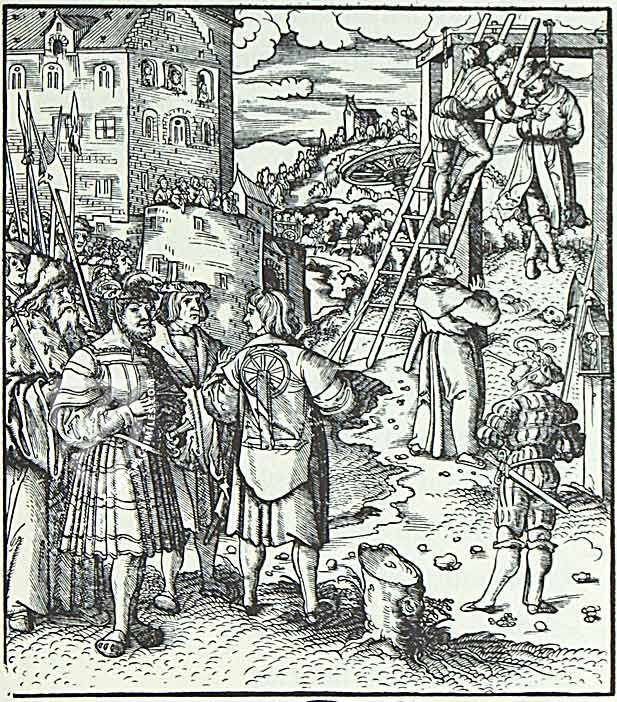
Emperor Maximilian I: Theuerdank
Theuerdank Jousts with another Knight
Among the many insights into life in the early–16th century that these woodcuts offer, its tournament scenes are among the most entertaining. This scene depicts Theuerdank and another knight in the moment that they have unseated one another. Both figures in full plate armor come crashing to the ground, feet in the air, broken lances flying.
The joust is occurring in the courtyard of a castle, which is partitioned off to separate the spectators from the action. An older, mustachioed man armed with a sword and a young page with a staff officiate the joust while two musicians, a male drummer and a female flautist, perform from a window in the background. The woodcut is remarkable for its detail, dynamism, spatiality, and perspective.
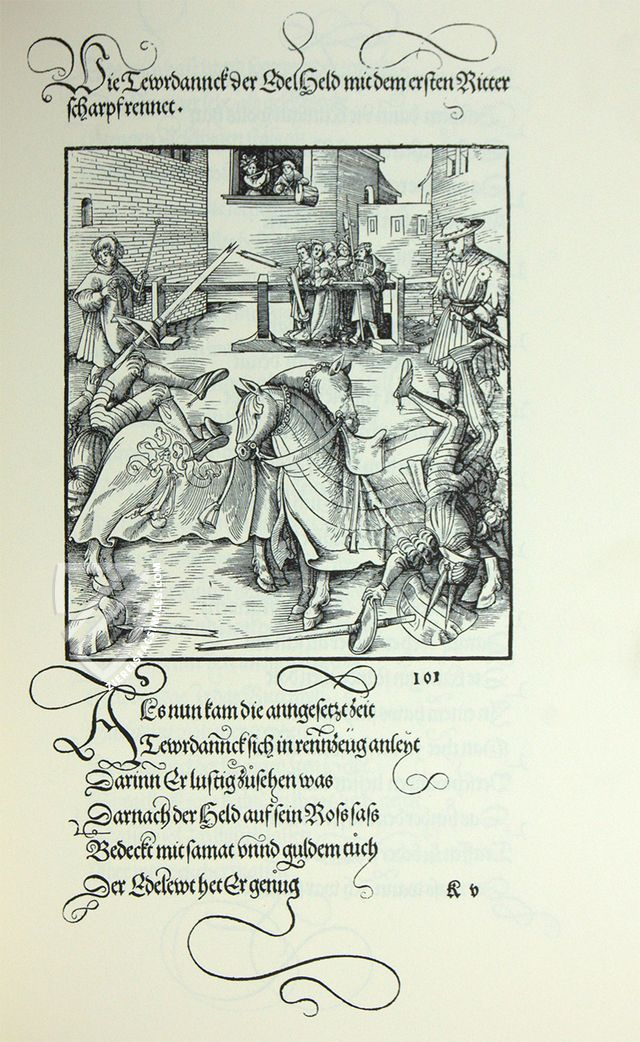
#1 Kaiser Maximilians Theuerdank (Leather Binding)
Language: German
(under 1,000€)
#2 Kaiser Maximilians Theuerdank (Linen Binding)
Language: German
(under 1,000€)
#3 Kaiser Maximilians Theuerdank (Parchment Binding)
Language: German
(1,000€ - 3,000€)
- Treatises / Secular Books
- Apocalypses / Beatus
- Astronomy / Astrology
- Bestiaries
- Bibles / Gospels
- Chronicles / History / Law
- Geography / Maps
- Saints' Lives
- Islam / Oriental
- Judaism / Hebrew
- Single Leaf Collections
- Leonardo da Vinci
- Literature / Poetry
- Liturgical Manuscripts
- Medicine / Botany / Alchemy
- Music
- Mythology / Prophecies
- Psalters
- Other Religious Books
- Games / Hunting
- Private Devotion Books
- Other Genres
- Afghanistan
- Armenia
- Austria
- Belgium
- Belize
- Bosnia and Herzegovina
- China
- Colombia
- Costa Rica
- Croatia
- Cyprus
- Czech Republic
- Denmark
- Egypt
- El Salvador
- Ethiopia
- France
- Germany
- Greece
- Guatemala
- Honduras
- Hungary
- India
- Iran
- Iraq
- Israel
- Italy
- Japan
- Jordan
- Kazakhstan
- Kyrgyzstan
- Lebanon
- Liechtenstein
- Luxembourg
- Mexico
- Morocco
- Netherlands
- Palestine
- Panama
- Peru
- Poland
- Portugal
- Romania
- Russia
- Serbia
- Spain
- Sri Lanka
- Sweden
- Switzerland
- Syria
- Tajikistan
- Turkey
- Turkmenistan
- Ukraine
- United Kingdom
- United States
- Uzbekistan
- Vatican City
- A. Oosthoek, van Holkema & Warendorf
- Aboca Museum
- Ajuntament de Valencia
- Akademie Verlag
- Akademische Druck- u. Verlagsanstalt (ADEVA)
- Aldo Ausilio Editore - Bottega d’Erasmo
- Alecto Historical Editions
- Alkuin Verlag
- Almqvist & Wiksell
- Amilcare Pizzi
- Andreas & Andreas Verlagsbuchhandlung
- Archa 90
- Archiv Verlag
- Archivi Edizioni
- Arnold Verlag
- ARS
- Ars Magna
- ArtCodex
- AyN Ediciones
- Azimuth Editions
- Badenia Verlag
- Bärenreiter-Verlag
- Belser Verlag
- Belser Verlag / WK Wertkontor
- Benziger Verlag
- Bernardinum Wydawnictwo
- BiblioGemma
- Biblioteca Apostolica Vaticana (Vaticanstadt, Vaticanstadt)
- Bibliotheca Palatina Faksimile Verlag
- Bibliotheca Rara
- Boydell & Brewer
- Bramante Edizioni
- Bredius Genootschap
- Brepols Publishers
- British Library
- C. Weckesser
- Caixa Catalunya
- Canesi
- CAPSA, Ars Scriptoria
- Caratzas Brothers, Publishers
- Carus Verlag
- Casamassima Libri
- Centrum Cartographie Verlag GmbH
- Chavane Verlag
- Christian Brandstätter Verlag
- Circulo Cientifico
- Club Bibliófilo Versol
- Club du Livre
- CM Editores
- Collegium Graphicum
- Collezione Apocrifa Da Vinci
- Comissão Nacional para as Comemorações dos Descobrimentos Portugueses
- Coron Verlag
- Corvina
- CTHS
- D. S. Brewer
- Damon
- De Agostini/UTET
- De Nederlandsche Boekhandel
- De Schutter
- Deuschle & Stemmle
- Deutscher Verlag für Kunstwissenschaft
- DIAMM
- Droz
- E. Schreiber Graphische Kunstanstalten
- Ediciones Boreal
- Ediciones Grial
- Ediclube
- Edições Inapa
- Edilan
- Editalia
- Edition Deuschle
- Edition Georg Popp
- Edition Leipzig
- Edition Libri Illustri
- Editiones Reales Sitios S. L.
- Éditions de l'Oiseau Lyre
- Editions Medicina Rara
- Editorial Casariego
- Editorial Mintzoa
- Editrice Antenore
- Editrice Velar
- Edizioni Edison
- Egeria, S.L.
- Eikon Editores
- Electa
- Emery Walker Limited
- Enciclopèdia Catalana
- Eos-Verlag
- Ephesus Publishing
- Ernst Battenberg
- Eugrammia Press
- Extraordinary Editions
- Fackelverlag
- Facsimila Art & Edition
- Facsimile Editions Ltd.
- Facsimilia Art & Edition Ebert KG
- Faksimile Verlag
- Feuermann Verlag
- Folger Shakespeare Library
- Franco Cosimo Panini Editore
- Friedrich Wittig Verlag
- Fundación Hullera Vasco-Leonesa
- G. Braziller
- Gabriele Mazzotta Editore
- Gebr. Mann Verlag
- Gesellschaft für graphische Industrie
- Getty Research Institute
- Giovanni Domenico de Rossi
- Giunti Editore
- Graffiti
- Grafica European Center of Fine Arts
- Guido Pressler
- Guillermo Blazquez
- Gustav Kiepenheuer
- H. N. Abrams
- Harrassowitz
- Harvard University Press
- Helikon
- Hendrickson Publishers
- Henning Oppermann
- Herder Verlag
- Hes & De Graaf Publishers
- Hoepli
- Holbein-Verlag
- Houghton Library
- Hugo Schmidt Verlag
- Idion Verlag
- Il Bulino, edizioni d'arte
- ILte
- Imago
- Insel Verlag
- Insel-Verlag Anton Kippenberger
- Instituto de Estudios Altoaragoneses
- Instituto Nacional de Antropología e Historia
- Introligatornia Budnik Jerzy
- Istituto dell'Enciclopedia Italiana - Treccani
- Istituto Ellenico di Studi Bizantini e Postbizantini
- Istituto Geografico De Agostini
- Istituto Poligrafico e Zecca dello Stato
- Italarte Art Establishments
- Jan Thorbecke Verlag
- Johnson Reprint Corporation
- Josef Stocker
- Josef Stocker-Schmid
- Jugoslavija
- Karl W. Hiersemann
- Kasper Straube
- Kaydeda Ediciones
- Kindler Verlag / Coron Verlag
- Kodansha International Ltd.
- Konrad Kölbl Verlag
- Kurt Wolff Verlag
- La Liberia dello Stato
- La Linea Editrice
- La Meta Editore
- Lambert Schneider
- Landeskreditbank Baden-Württemberg
- Leo S. Olschki
- Les Incunables
- Liber Artis
- Library of Congress
- Libreria Musicale Italiana
- Lichtdruck
- Lito Immagine Editore
- Lumen Artis
- Lund Humphries
- M. Moleiro Editor
- Maison des Sciences de l'homme et de la société de Poitiers
- Manuscriptum
- Martinus Nijhoff
- Maruzen-Yushodo Co. Ltd.
- MASA
- Massada Publishers
- McGraw-Hill
- Metropolitan Museum of Art
- Militos
- Millennium Liber
- Müller & Schindler
- Nahar - Stavit
- Nahar and Steimatzky
- National Library of Wales
- Neri Pozza
- Nova Charta
- Oceanum Verlag
- Odeon
- Orbis Mediaevalis
- Orbis Pictus
- Österreichische Staatsdruckerei
- Oxford University Press
- Pageant Books
- Parzellers Buchverlag
- Patrimonio Ediciones
- Pattloch Verlag
- PIAF
- Pieper Verlag
- Plon-Nourrit et cie
- Poligrafiche Bolis
- Presses Universitaires de Strasbourg
- Prestel Verlag
- Princeton University Press
- Prisma Verlag
- Priuli & Verlucca, editori
- Pro Sport Verlag
- Propyläen Verlag
- Pytheas Books
- Quaternio Verlag Luzern
- Reales Sitios
- Recht-Verlag
- Reichert Verlag
- Reichsdruckerei
- Reprint Verlag
- Riehn & Reusch
- Roberto Vattori Editore
- Rosenkilde and Bagger
- Roxburghe Club
- Salerno Editrice
- Saltellus Press
- Sandoz
- Sarajevo Svjetlost
- Schöck ArtPrint Kft.
- Schulsinger Brothers
- Scolar Press
- Scrinium
- Scripta Maneant
- Scriptorium
- Shazar
- Siloé, arte y bibliofilia
- SISMEL - Edizioni del Galluzzo
- Sociedad Mexicana de Antropología
- Société des Bibliophiles & Iconophiles de Belgique
- Soncin Publishing
- Sorli Ediciones
- Stainer and Bell
- Studer
- Styria Verlag
- Sumptibus Pragopress
- Szegedi Tudomànyegyetem
- Taberna Libraria
- Tarshish Books
- Taschen
- Tempus Libri
- Testimonio Compañía Editorial
- Thames and Hudson
- The Clear Vue Publishing Partnership Limited
- The Facsimile Codex
- The Folio Society
- The Marquess of Normanby
- The Richard III and Yorkist History Trust
- Tip.Le.Co
- TouchArt
- TREC Publishing House
- TRI Publishing Co.
- Trident Editore
- Tuliba Collection
- Typis Regiae Officinae Polygraphicae
- Union Verlag Berlin
- Universidad de Granada
- University of California Press
- University of Chicago Press
- Urs Graf
- Vallecchi
- Van Wijnen
- VCH, Acta Humaniora
- VDI Verlag
- VEB Deutscher Verlag für Musik
- Verlag Anton Pustet / Andreas Verlag
- Verlag Bibliophile Drucke Josef Stocker
- Verlag der Münchner Drucke
- Verlag für Regionalgeschichte
- Verlag Styria
- Vicent Garcia Editores
- W. Turnowski Ltd.
- W. Turnowsky
- Waanders Printers
- Wiener Mechitharisten-Congregation (Wien, Österreich)
- Wissenschaftliche Buchgesellschaft
- Wissenschaftliche Verlagsgesellschaft
- Wydawnictwo Dolnoslaskie
- Xuntanza Editorial
- Zakład Narodowy
- Zollikofer AG

